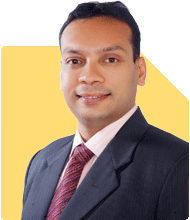Ramalingam Kalirajan |5367 Answers |Ask -Follow
Mutual Funds, Financial Planning Expert - Answered on Jun 10, 2024
He has an MBA in finance from the University of Madras and is a certified financial planner.
He is the director and chief financial planner at Holistic Investment, a Chennai-based firm that offers financial planning and wealth management advice.... more

I am 38 year old I have 20 lakh retirement date sept 2024 with 23000 pension after 10 year I need 2 CR how can I get
Firstly, congratulations on approaching retirement with a solid foundation. At 38 years old, having Rs 20 lakh in savings and a pension of Rs 23,000 per month starting in 10 years is commendable. Your goal of accumulating Rs 2 crore by retirement requires careful planning and disciplined investing.
Income Management
Effective income management is essential to achieve your financial goals. Let’s break down your current and future income streams.
Current Savings: You have Rs 20 lakh in savings. This is a substantial amount to start with.
Pension Income: You will receive Rs 23,000 per month starting in 10 years. This will help cover your basic living expenses.
Additional Savings: Continue to save and invest any surplus income. Aim to increase your savings rate as your income grows.
Careful income management ensures you have the funds needed for investments and future expenses.
Setting Clear Financial Goals
To accumulate Rs 2 crore by your retirement date in September 2024, you need to set clear financial goals. Here’s how you can approach it:
Target Amount: You need to grow your savings to Rs 2 crore in the next 16 years.
Investment Horizon: With 16 years to invest, you can take advantage of compounding growth.
Risk Tolerance: Assess your risk tolerance to choose appropriate investment vehicles.
Setting clear goals helps in creating a focused and effective investment strategy.
Investment Strategy
Achieving your goal of Rs 2 crore requires a well-diversified investment strategy. Let’s explore different investment options.
Mutual Funds
Mutual funds are an excellent way to diversify your investments and achieve long-term growth. Here’s how to approach mutual fund investments:
Diversified Portfolio: Invest in a mix of equity, debt, and hybrid mutual funds. This spreads risk and optimizes returns.
Systematic Investment Plan (SIP): Consider starting a SIP to invest regularly. This reduces the impact of market volatility and ensures disciplined investing.
Active Management: Actively managed funds offer professional management and the potential to outperform passive funds. This can enhance your returns.
Regular Review: Review your mutual fund portfolio periodically. Ensure it aligns with your financial goals and risk tolerance.
Mutual funds provide diversification, professional management, and the potential for high returns, making them ideal for long-term goals.
Equity Investments
Equity investments can offer significant growth over the long term. Here’s how to approach equity investments:
Long-Term Focus: Focus on long-term investments rather than short-term trading. This allows you to benefit from the compounding effect.
Blue-Chip Stocks: Invest in blue-chip stocks with strong fundamentals and growth potential. These companies offer stability and consistent returns.
Diversification: Diversify your equity investments across different sectors. This reduces risk and capitalizes on various market opportunities.
Research and Analysis: Stay informed about market trends and company performance. Use this knowledge to make informed investment decisions.
Long-term equity investments can provide substantial growth, helping you reach your financial goals.
Fixed Deposits
Fixed deposits offer stability and guaranteed returns. However, they may not provide the high returns needed to reach your goal. Here’s how to use fixed deposits effectively:
Short-Term Needs: Use fixed deposits for short-term financial needs and emergencies. This ensures liquidity and capital protection.
Interest Rates: Ensure you get the best interest rates available. Compare rates from different banks and financial institutions.
Laddering Strategy: Use a laddering strategy by splitting your investment into multiple fixed deposits with different maturity dates. This provides regular liquidity and reduces interest rate risk.
Fixed deposits offer stability and can be part of your conservative investment strategy.
Gold Bonds
Gold bonds are a good hedge against inflation and currency devaluation. Here’s how to include gold bonds in your portfolio:
Diversification: Continue holding gold bonds as part of your diversified portfolio. They provide a safe investment avenue.
Tax Benefits: Gold bonds offer tax benefits on capital gains if held until maturity. This enhances your overall returns.
Hedge Against Inflation: Gold bonds protect against inflation, preserving your purchasing power over time.
Gold bonds add value to your portfolio by providing a stable and inflation-proof investment option.
Planning for Retirement
Planning for retirement is crucial to ensure financial independence in your later years. Here’s how to approach retirement planning:
Retirement Corpus: Aim to accumulate Rs 2 crore by your retirement date. This provides a substantial corpus to support your retirement lifestyle.
Pension Income: Your pension of Rs 23,000 per month will supplement your retirement corpus. This helps cover basic living expenses.
Withdrawal Strategy: Develop a withdrawal strategy to ensure your retirement corpus lasts throughout your retirement years. Consider withdrawing 4-5% of your corpus annually.
Healthcare Costs: Plan for healthcare costs in retirement. Consider investing in health insurance to cover medical expenses.
Effective retirement planning ensures financial security and peace of mind in your later years.
Tax Planning
Effective tax planning maximizes your savings and investments. Here’s how to approach tax planning:
Tax-Saving Investments: Utilize Section 80C deductions through investments in PPF, ELSS, and NSC. This reduces your taxable income.
Health Insurance: Claim deductions under Section 80D for health insurance premiums for yourself and your family.
Home Loan Benefits: Use the tax benefits on home loan interest and principal repayments.
Consult a tax professional to optimize your tax-saving strategy.
Regular Financial Review
Regular financial reviews help in staying on track with your financial goals. Here’s how to approach financial reviews:
Annual Review: Conduct an annual review of your income, expenses, and investments. Adjust your strategy as needed.
Life Changes: Reassess your financial plan after major life events like a job change, a new child, or a significant investment.
Market Conditions: Stay updated with market conditions. Adjust your investment portfolio based on market trends and economic changes.
Regular reviews ensure your financial plan remains aligned with your goals.
Professional Guidance
Consulting a Certified Financial Planner can provide personalized advice and expert guidance. Here’s how a CFP can help:
Financial Plan: A CFP can help create a comprehensive financial plan tailored to your needs.
Investment Advice: Benefit from their expertise in selecting and managing investments.
Goal Setting: Work with a CFP to set realistic financial goals and develop strategies to achieve them.
Professional guidance ensures you make informed financial decisions and achieve your financial objectives.
Financial Security for Your Family
Ensuring your family’s financial security is a top priority. Here’s how to approach family financial security:
Insurance Coverage: Ensure you have adequate health and life insurance coverage. This protects your family in case of unforeseen events.
Emergency Fund: Maintain a robust emergency fund to cover unexpected expenses. This provides financial stability and peace of mind.
Estate Planning: Plan your estate to ensure your assets are distributed according to your wishes. Consider writing a will and setting up a trust.
Financial security for your family provides peace of mind and stability.
Financial Discipline
Maintaining financial discipline is key to achieving your goals. Here’s how to approach financial discipline:
Budgeting: Stick to your budget and avoid unnecessary expenses. This ensures you have funds available for savings and investments.
Debt Management: Avoid accumulating high-interest debt like credit card balances. Pay off existing debts to free up funds for investments.
Consistent Investments: Continue investing regularly and avoid withdrawing from long-term investments prematurely. This ensures your investments grow over time.
Financial discipline ensures you stay on track and achieve your financial objectives.
Final Insights
Your current financial position is strong, with a solid foundation and a clear goal of accumulating Rs 2 crore by retirement. By optimizing your strategy, you can achieve this goal and ensure a prosperous future. Focus on diversified investments, disciplined savings, and regular financial reviews. Consult a Certified Financial Planner for personalized advice and guidance. Your financial journey is a marathon, not a sprint. With discipline, planning, and professional guidance, you will achieve your financial goals and enjoy a comfortable retirement.
Best Regards,
K. Ramalingam, MBA, CFP
Chief Financial Planner
www.holisticinvestment.in
You may like to see similar questions and answers below
Ramalingam Kalirajan |5367 Answers |Ask -Follow
Mutual Funds, Financial Planning Expert - Answered on May 18, 2024
Ramalingam Kalirajan |5367 Answers |Ask -Follow
Mutual Funds, Financial Planning Expert - Answered on Jun 03, 2024
Ramalingam Kalirajan |5367 Answers |Ask -Follow
Mutual Funds, Financial Planning Expert - Answered on Jun 29, 2024
Ramalingam Kalirajan |5367 Answers |Ask -Follow
Mutual Funds, Financial Planning Expert - Answered on Jul 25, 2024
Ramalingam Kalirajan |5367 Answers |Ask -Follow
Mutual Funds, Financial Planning Expert - Answered on Jul 17, 2024
Dr Nagarajan J S K |58 Answers |Ask -Follow
Health Science and Pharmaceutical Careers Expert - Answered on Jul 27, 2024
Dr Nagarajan J S K |58 Answers |Ask -Follow
Health Science and Pharmaceutical Careers Expert - Answered on Jul 27, 2024
Dr Nagarajan J S K |58 Answers |Ask -Follow
Health Science and Pharmaceutical Careers Expert - Answered on Jul 26, 2024
Krishna Kumar |358 Answers |Ask -Follow
Workplace Expert - Answered on Jul 26, 2024
Krishna Kumar |358 Answers |Ask -Follow
Workplace Expert - Answered on Jul 26, 2024
Krishna Kumar |358 Answers |Ask -Follow
Workplace Expert - Answered on Jul 26, 2024
Krishna Kumar |358 Answers |Ask -Follow
Workplace Expert - Answered on Jul 26, 2024
Krishna Kumar |358 Answers |Ask -Follow
Workplace Expert - Answered on Jul 26, 2024
Krishna Kumar |358 Answers |Ask -Follow
Workplace Expert - Answered on Jul 26, 2024
Krishna Kumar |358 Answers |Ask -Follow
Workplace Expert - Answered on Jul 26, 2024




















